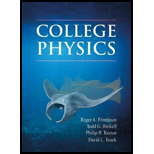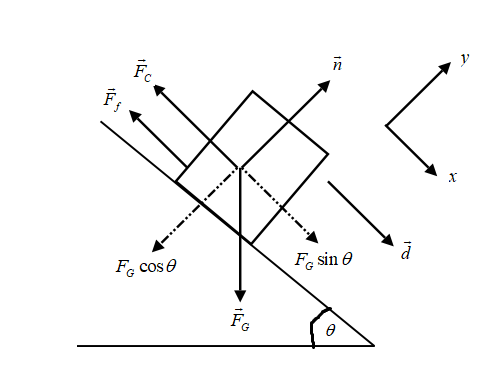
Concept explainers
(a)
The work done by the gravitational force on the statue.
Answer to Problem 43QAP
The work done by the gravitational force on the statue is
Explanation of Solution
Given:
Mass of the crate
Angle made by the inclined plane with the horizontal
Displacement of the crate along the plane
Coefficient of kinetic friction between the crate and the plane
Formula used:
Draw a free body diagram representing the forces and apply the condition for dynamic equilibrium. Work done by a force is given by the product of the force and the displacement along the direction of force.
Calculation:
Draw the free body diagram for the forces and assume the positive direction of the x axis down the plane.

Figure 1
The gravitational force
The magnitude of the gravitational force is given by,
Resolve the gravitational force
Therefore,
The work done by the x component of the gravitational force is given by,
Substitute the known values of the variables in the above equation.
The work done by the y component of the gravitational force is given by,
Substitute the known values of the variables in the above equation.
Therefore the work done by the gravitational force is given by,
Conclusion:
Thus the work done by the gravitational force on the statue is
(b)
Work done by the Curator in pushing the statue up the incline.
Answer to Problem 43QAP
The work done by the Curator in pushing the statue up the incline is
Explanation of Solution
Given:
Mass of the crate
Angle made by the inclined plane with the horizontal
Displacement of the crate along the plane
Coefficient of kinetic friction between the crate and the plane
Calculation:
The crate moves with a constant velocity, hence it is in dynamic equilibrium. The sum of the forces along the x and the y directions, independently add up to zero.
Use Fig 1, and apply the condition of equilibrium along the y axis.
From equation (3)
The magnitude of the force of friction and the normal force are related as follows:
From equation (4),
The force of friction acts along the − x axis.
Therefore,
Apply the condition of equilibrium along the x direction.
Therefore,
Use equations (2)
Substitute the known values of the variables in the above equation.
Write the expression for the work done by the Curator.
Substitute the values of the variables in the above equation.
Conclusion:
Thus the work done by the Curator in pushing the statue up the incline is
(c)
The work done by the friction force on the crate
Answer to Problem 43QAP
The work done by the friction force on the crate is
Explanation of Solution
Given:
Mass of the crate
Angle made by the inclined plane with the horizontal
Displacement of the crate along the plane
Coefficient of kinetic friction between the crate and the plane
Formula used:
The work done by the
Calculation:
Use equation (5)
Substitute the known values of the variables in the equation.
Conclusion:
Thus, the work done by the friction force on the crate is
(d)
The work done by the normal force between the crate and the incline.
Answer to Problem 43QAP
The work done by the normal force between the crate and the incline is 0.
Explanation of Solution
Given:
The expressions for normal force and displacement.
Formula used:
The work done by the normal force is given by,
Calculation:
Substitute the given values of the vectors in the formula.
Conclusion:
Thus the work done by the normal force between the crate and the incline is 0.
Want to see more full solutions like this?
Chapter 6 Solutions
COLLEGE PHYSICS
- a) Consider the following function, where A is a constant. y(x,t) = A(x — vt). Can this represent a wave that travels along? Explain. b) Which of the following are possible traveling waves, provide your reasoning and give the velocity of the wave if it can be a traveling wave. e-(a²x²+b²²-2abtx b.1) y(x,t) b.2) y(x,t) = = A sin(ax² - bt²). 2 b.3) y(x,t) = A sin 2π (+) b.4) y(x,t) = A cos² 2π(t-x). b.5) y(x,t) = A cos wt sin(kx - wt)arrow_forwardThe capacitor in (Figure 1) is initially uncharged. The switch is closed at t=0. Immediately after the switch is closed, what is the current through the resistor R1, R2, and R3? What is the final charge on the capacitor? Please explain all steps.arrow_forwardSuppose you have a lens system that is to be used primarily for 620-nm light. What is the second thinnest coating of fluorite (calcium fluoride) that would be non-reflective for this wavelength? × nm 434arrow_forward
- The angle between the axes of two polarizing filters is 19.0°. By how much does the second filter reduce the intensity of the light coming through the first? I = 0.106 40 xarrow_forwardAn oil slick on water is 82.3 nm thick and illuminated by white light incident perpendicular to its surface. What color does the oil appear (what is the most constructively reflected wavelength, in nanometers), given its index of refraction is 1.43? (Assume the index of refraction of water is 1.33.) wavelength color 675 × nm red (1 660 nm)arrow_forwardA 1.50 μF capacitor is charging through a 16.0 Ω resistor using a 15.0 V battery. What will be the current when the capacitor has acquired 1/4 of its maximum charge? Please explain all stepsarrow_forward
- In the circuit shown in the figure (Figure 1), the 6.0 Ω resistor is consuming energy at a rate of 24 J/s when the current through it flows as shown. What are the polarity and emf of the battery E, assuming it has negligible internal resistance? Please explain all steps. I know you need to use the loop rule, but I keep getting the answer wrong.arrow_forwardIf you connect a 1.8 F and a 2.6 F capacitor in series, what will be the equivalent capacitance?arrow_forwardSuppose that a particular heart defibrillator uses a 1.5 x 10-5 Farad capacitor. If it is charged up to a voltage of 7300 volts, how much energy is stored in the capacitor? Give your answer as the number of Joules.arrow_forward
- The voltage difference across an 8.3 nanometer thick cell membrane is 6.5 x 10-5volts. What is the magnitude of the electric field inside this cell membrane? (Assume the field is uniform, and give your answer as the number of Volts per meter... which is the same as the number of Newtons per Coulomb.)arrow_forwardThree identical capacitors are connected in parallel. When this parallel assembly of capacitors is connected to a 12 volt battery, a total of 3.1 x 10-5 coulombs flows through the battery. What is the capacitance of one individual capacitor? (Give your answer as the number of Farads.)arrow_forwardSuppose you construct your own capacitor by placing two parallel plates at a distance 0.27 meters apart. The plates each have a surface area of 0.64 square meters. What is the capacitance of this setup? (Give your answer as the number of Farads.)arrow_forward
 University Physics Volume 1PhysicsISBN:9781938168277Author:William Moebs, Samuel J. Ling, Jeff SannyPublisher:OpenStax - Rice University
University Physics Volume 1PhysicsISBN:9781938168277Author:William Moebs, Samuel J. Ling, Jeff SannyPublisher:OpenStax - Rice University Glencoe Physics: Principles and Problems, Student...PhysicsISBN:9780078807213Author:Paul W. ZitzewitzPublisher:Glencoe/McGraw-Hill
Glencoe Physics: Principles and Problems, Student...PhysicsISBN:9780078807213Author:Paul W. ZitzewitzPublisher:Glencoe/McGraw-Hill Principles of Physics: A Calculus-Based TextPhysicsISBN:9781133104261Author:Raymond A. Serway, John W. JewettPublisher:Cengage Learning
Principles of Physics: A Calculus-Based TextPhysicsISBN:9781133104261Author:Raymond A. Serway, John W. JewettPublisher:Cengage Learning Physics for Scientists and Engineers, Technology ...PhysicsISBN:9781305116399Author:Raymond A. Serway, John W. JewettPublisher:Cengage Learning
Physics for Scientists and Engineers, Technology ...PhysicsISBN:9781305116399Author:Raymond A. Serway, John W. JewettPublisher:Cengage Learning An Introduction to Physical SciencePhysicsISBN:9781305079137Author:James Shipman, Jerry D. Wilson, Charles A. Higgins, Omar TorresPublisher:Cengage Learning
An Introduction to Physical SciencePhysicsISBN:9781305079137Author:James Shipman, Jerry D. Wilson, Charles A. Higgins, Omar TorresPublisher:Cengage Learning College PhysicsPhysicsISBN:9781305952300Author:Raymond A. Serway, Chris VuillePublisher:Cengage Learning
College PhysicsPhysicsISBN:9781305952300Author:Raymond A. Serway, Chris VuillePublisher:Cengage Learning





